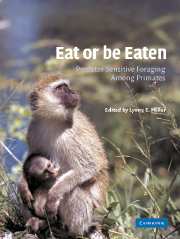Book contents
- Frontmatter
- Contents
- List of contributors
- Preface
- 1 An introduction to predator sensitive foraging
- PART I BIOLOGICAL VARIABLES
- 2 Dangers in the dark: Are some nocturnal primates afraid of the dark?
- 3 Predation sensitive foraging in captive tamarins
- 4 Seeing red: Consequence of individual differences in color vision in callitrichid primates
- 5 Predator sensitive foraging in Thomas langurs
- PART II SOCIAL VARIABLES
- PART III ENVIRONMENTAL VARIABLES
- Index
3 - Predation sensitive foraging in captive tamarins
Published online by Cambridge University Press: 10 November 2009
- Frontmatter
- Contents
- List of contributors
- Preface
- 1 An introduction to predator sensitive foraging
- PART I BIOLOGICAL VARIABLES
- 2 Dangers in the dark: Are some nocturnal primates afraid of the dark?
- 3 Predation sensitive foraging in captive tamarins
- 4 Seeing red: Consequence of individual differences in color vision in callitrichid primates
- 5 Predator sensitive foraging in Thomas langurs
- PART II SOCIAL VARIABLES
- PART III ENVIRONMENTAL VARIABLES
- Index
Summary
Introduction
Tamarins of the genus Saguinus are small bodied (250–650 g: Hershkovitz 1977, Napier and Napier 1967, Snowdon and Soini 1988), Neotropical, diurnal, arboreal frugivore–insectivores, some of which form stable mixed-species troops (saddle-backed tamarin (S. fuscicollis) with either moustached tamarin (S. mystax), red-bellied tamarin (S. labiatus) or emperor tamarin (S. imperator): see Heymann and Buchanan-Smith 2000 for a review). They are vulnerable to a wide range of predatory birds, reptiles and mammals (Buchanan-Smith 1990, Dawson 1979, Emmons 1987, Hershkovitz 1977, Heymann 1987, 1990, Izawa 1978, Neyman 1978, Terborgh 1983), and it has been suggested that, due to their small size, they have higher rates of predation relative to large-bodied primates (Caine 1993, Cheney and Wrangham 1987, Terborgh 1990).
Given such high predation risk, and given that they typically spend around 60% of their daily activity period foraging for their food (Soini 1987, Terborgh 1983), it is expected that antipredatory considerations may impose strong constraints on tamarin foraging behavior. The antipredatory behavior of callitrichines suggests that early detection and consequent avoidance of predators is the most effective mechanism to decrease predation. For example, in response to aerial predation, tamarins appear to rely on crypsis (i.e., remaining immobile, hiding beneath foliage), retreating from the periphery of a tree (where many of their fruits are found) to the tree trunk or, most dramatically, free-falling to the ground (e.g., Caine 1987, Dawson 1979, Heymann 1990, Peres 1991). Heymann (1990) observed a mixed-species troop of saddle-backed tamarins and moustached tamarins to remain immobile for almost 4 hours following an observed attack by the ornate hawk-eagle (Spizaetus ornatus).
- Type
- Chapter
- Information
- Eat or be EatenPredator Sensitive Foraging Among Primates, pp. 44 - 57Publisher: Cambridge University PressPrint publication year: 2002
- 5
- Cited by



